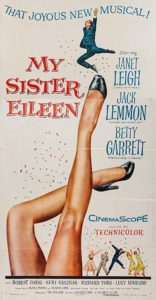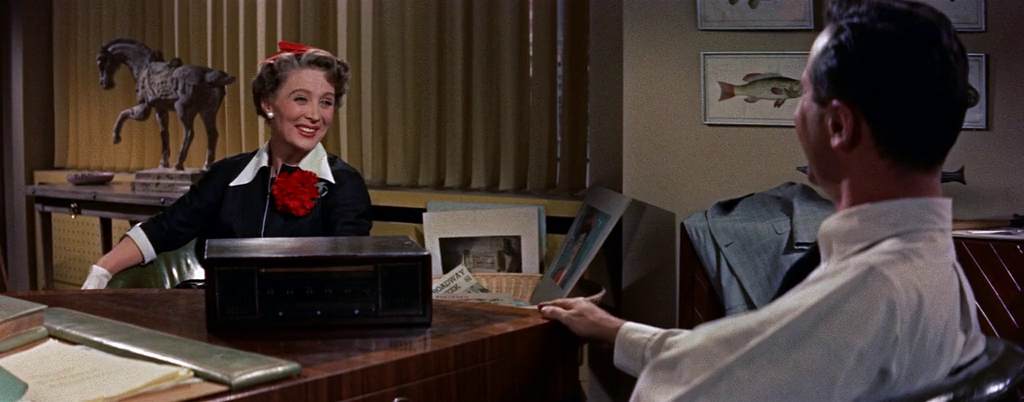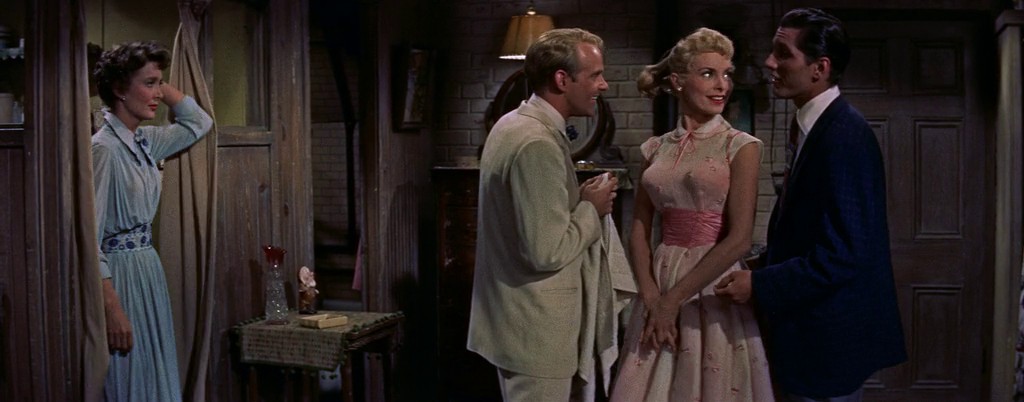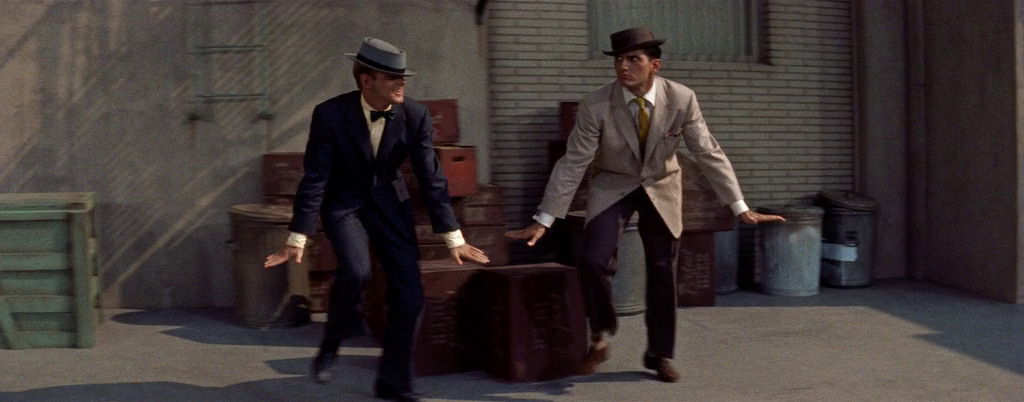“Oh, they were interested — but not in my acting.”
|

Synopsis:
A writer (Betty Garrett) and her aspiring-actress sister Eileen (Janet Leigh) move to New York City and are convinced by a Greek landlord (Kurt Kaszner) to rent a basement apartment next to an out-of-work wrestler (Dick York) and his girlfriend (Lucy Marlow). Busty Eileen draws attention everywhere she goes — specifically from a soda fountain manager (Bob Fosse) and his acquaintance (Tommy Rall); meanwhile, Ruth (Garrett) tries to sell some of her stories about life with her attractive sister to a publisher (Jack Lemmon) who believes Garrett is “Eileen”.
|
|
Genres, Themes, Actors, and Directors:
- Brian Aherne Films
- Jack Lemmon Films
- Janet Leigh
- Musicals
- New York City
- Writers
Review:
Bob Fosse choreographed and co-starred in this enjoyable Cinemascope musical — based on a 1940 play by Jerome Chodorov and Joseph Fields — which was itself inspired by Ruth McKenney’s autobiographical stories. The storyline, focusing on two young hopefuls navigating The Big City, remains as timeless as ever, and while it’s challenging to watch Eileen literally harassed wherever she goes, we can contextualize the scenario as “of the era” and be grateful we’ve moved on at least somewhat (or have we?). Garrett is pitch-perfect in the leading role, and Leigh is appropriately guileless as her lovable sister; there’s no way one could dislike Eileen as portrayed here. The musical sequences are a delight, and it’s fun to see Fosse himself on-screen. I also happen to enjoy the subplot about “Wreck” (York) hanging around the apartment making himself useful, his “unique”, oh-so-New-York relationship with Marlow unthreatened by Leigh’s presence.
Redeeming Qualities and Moments:
- Betty Garrett as Ruth

- Janet Leigh as Eileen

- Fun musical sequences (choreographed by Bob Fosse)


- Fine Cinemascope cinematography

- An enjoyably witty script

Must See?
Yes, as an enjoyable musical. Listed as a Personal Recommendation in the back of Peary’s book.
Categories
Links:
|
2 thoughts on “My Sister Eileen (1955)”
Not must-see – *unless* you’re a fan of Fosse’s work and/or the music of Jule Styne, in which case it’s a once-must.
I don’t mean to dampen the enthusiasm expressed in the assessment above but, aside from the strong points I noted, this comes off to me as merely a very mildly amusing entertainment that’s somewhat sadly dated.
The cast certainly can’t be faulted – but the energy is compensating for low comedy. (As well… although we’re supposed to be forgiving when it comes to material this light, I was bothered from the midway point over the issue of money. At that point, Ruth and Eileen have all but run out of cash – yet there’s still half a film to go, so I kept thinking, ‘What are they doing for money?’ That problem could have been solved if, instead of saying “We only have $20 left.”, Ruth said, “We’re getting low.”)
It becomes noticeable that the only times the film actually comes *alive* is during Fosse’s routines (with a wide variety of his signature moves, etc.) and Styne’s music (with many clever lyrics by Leo Robin). Styne’s score is actually better than the one Bernstein wrote for ‘Wonderful Town’ (see IMDb comment I’m attaching below) – for one thing, it’s memorable. (Styne only borrows one idea – the Conga – from the Bernstein score.)
This musical version of the 1942 ‘Eileen’ film (in which the director of the musical film – Richard Quine – played Frank; a role he also played in the original play) had a very twisty road in development, as IMDb reveals:
[Columbia Pictures’ original plan was to make the film version of the 1953 Broadway hit “Wonderful Town,” which had been based on the Columbia property My Sister Eileen (1942). Whereas Rosalind Russell had starred in both the original Columbia film and the stage musical, the studio wanted “Wonderful Town” specifically for its reigning comedy star Judy Holliday. However, the asking price for the rights to the Leonard Bernstein/Betty Comden/Adolph Green score was so steep that Columbia decided to pass on the stage show and go ahead with its own version, keeping the original title, which they already owned, and commissioning a new score from Jule Styne and Leo Robin. Ironically, by the time the wheels were in motion, Holliday was committed to a Broadway show of her own, Bells Are Ringing (1956), and Russell was tied up with the stage version of Auntie Mame (1956) — all of which paved the way for Betty Garrett stepping into the role of Ruth. Garrett was a surprise choice, as she had been off the screen for several years following the termination of her MGM contract, and she was primarily appearing in nightclubs and summer stock with her husband Larry Parks, whose career had crumbled following the McCarthy-era blacklist. Though she received third billing (Janet Leigh was top-billed) and lacked the star quality of Holliday or Russell, My Sister Eileen was inarguably the finest hour of her career. In a further twist, once filming was completed, Garrett returned to New York to step in for Judy Holliday while she took her two-week vacation from Bells Are Ringing. Meantime, Wonderful Town finally came to the screen in 1958, albeit on television, in a faithful, complete two-hour broadcast that allowed Russell to reprise and preserve her Tony Award-winning performance, and prompted Columbia Records to release a sound track album from the show — a further irony, as no sound track album was released for My Sister Eileen.]
Appreciate David’s comments. Quite a history.
I loved Betty Garrett finally getting a starring role. My favorite number was “Give Me a Band and my Baby.”
I was lucky enough to see Betty in person on Broadway in 1990. She played the part of the maid ( Marjorie Main in the movie) in “Meet Me in St. Louis.” And her one woman show in London.
Wish she had made a film with her husband Larry Parks.
Great to see Rosalind Russell in the TV version of “Wonderful Town”.